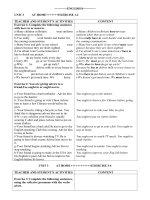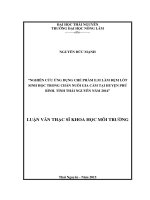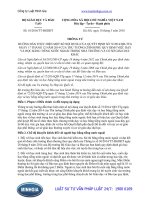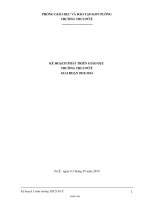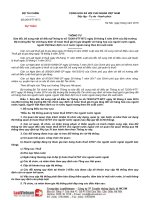E 307 72 (2014)
Bạn đang xem bản rút gọn của tài liệu. Xem và tải ngay bản đầy đủ của tài liệu tại đây (100.97 KB, 6 trang )
Designation: E307 − 72 (Reapproved 2014)
Standard Test Method for
Normal Spectral Emittance at Elevated Temperatures1
This standard is issued under the fixed designation E307; the number immediately following the designation indicates the year of
original adoption or, in the case of revision, the year of last revision. A number in parentheses indicates the year of last reapproval. A
superscript epsilon (´) indicates an editorial change since the last revision or reapproval.
specimen; it is the ratio of radiant flux emitted by a specimen
per unit area (thermal-radiant exitance) to that emitted by a
blackbody radiator at the same temperature and under the same
conditions. Emittance must be further qualified in order to
convey a more precise meaning. Thermal-radiant exitance that
occurs in all possible directions is referred to as hemispherical
thermal-radiant exitance. When limited directions of propagation or observation are involved, the word directional thermalradiant exitance is used. Thus, normal thermal-radiant exitance
is a special case of directional thermal-radiant exitance, and
means in a direction perpendicular (normal) to the surface.
Therefore, spectral normal emittance refers to the radiant flux
emitted by a specimen within a narrow wavelength interval
centered on a specific wavelength and emitted in a direction
normal to the plane of an incremental area of a specimen’s
surface. These restrictions in angle occur usually by the
method of measurement rather than by radiant flux emission
properties.
1. Scope
1.1 This test method describes a highly accurate technique
for measuring the normal spectral emittance of electrically
conducting materials or materials with electrically conducting
substrates, in the temperature range from 600 to 1400 K, and at
wavelengths from 1 to 35 µm.
1.2 The test method requires expensive equipment and
rather elaborate precautions, but produces data that are accurate to within a few percent. It is suitable for research
laboratories where the highest precision and accuracy are
desired, but is not recommended for routine production or
acceptance testing. However, because of its high accuracy this
test method can be used as a referee method to be applied to
production and acceptance testing in cases of dispute.
1.3 The values stated in SI units are to be regarded as the
standard. The values in parentheses are for information only.
1.4 This standard does not purport to address all of the
safety concerns, if any, associated with its use. It is the
responsibility of the user of this standard to establish appropriate safety and health practices and determine the applicability of regulatory limitations prior to use.
NOTE 1—All the terminology used in this test method has not been
standardized. Terminology E349 contain some approved terms. When
agreement on other standard terms is reached, the definitions used herein
will be revised as required.
4. Summary of Test Method
2. Referenced Documents
4.1 The principle of the test method is a direct comparison
of the radiant flux from a specimen at a given temperature to
the radiant flux of a blackbody at the same temperature and
under the same environmental conditions of atmosphere and
pressure. The details of this test method are given by Harrison
et al (3) and Richmond et al (4).
2.1 ASTM Standards:2
E349 Terminology Relating to Space Simulation
3. Terminology
3.1 Definitions of Terms Specific to This Standard:
3.1.1 spectral normal emittance—the term as used in this
specification follows that advocated by Jones (1),3 Worthing
(2), and others, in that the word emittance is a property of a
4.2 The essential features of the test method are the use of
a double-beam ratio-recording infrared spectrophotometer with
variable slit widths, which combines and compares the signals
from the specimen and the reference blackbody through a
monochromator system which covers the wavelength range
from 1 to 35 µm (Note 2). According to Harrison et al (3) a
differential thermocouple with suitable instrumentation is used
to maintain a heated specimen and the blackbody at the same
temperature.
1
This test method is under the jurisdiction of ASTM Committee E21 on Space
Simulation and Applications of Space Technology and is the direct responsibility of
Subcommittee E21.04 on Space Simulation Test Methods.
Current edition approved April 1, 2014. Published April 2014. Originally
approved in 1968. Last previous edition approved in 2008 as E307 – 72(2008). DOI:
10.1520/E0307-72R14.
2
For referenced ASTM standards, visit the ASTM website, www.astm.org, or
contact ASTM Customer Service at For Annual Book of ASTM
Standards volume information, refer to the standard’s Document Summary page on
the ASTM website.
3
The boldface numbers in parentheses refer to the list of references at the end of
this test method.
NOTE 2—An electronic-null, ratio-recording spectrophotometer is preferred to an optical-null instrument for this use. It may be difficult to
obtain and maintain linearity of response of an optical-null instrument if
the optical paths are not identical to those of the instrument as manufactured.
Copyright © ASTM International, 100 Barr Harbor Drive, PO Box C700, West Conshohocken, PA 19428-2959. United States
1
E307 − 72 (2014)
measured. Operation of the spectrophotometer at a higher
sensitivity level or in a single-beam mode can be used to
evaluate band-pass effects. In a prism instrument, several
prisms compositions can be used to cover the complete
wavelength range; however, a sodium chloride prism is typically used to cover the spectral range from 1.0 to 15 µm, and
a cesium bromide prism used to cover the spectral range from
15 to 35 µm. As a detector, a vacuum thermocouple with a
sodium chloride window is used in the spectral range from 1 to
15 µm, and a vacuum thermocouple with a cesium bromide
window in the spectral range from 1 to 35 µm. A black
polyethylene filter is used to limit stray radiation in the 15 to
35-µm range.
5. Significance and Use
5.1 The significant features are typified by a discussion of
the limitations of the technique. With the description and
arrangement given in the following portions of this test
method, the instrument will record directly the normal spectral
emittance of a specimen. However, the following conditions
must be met within acceptable tolerance:
5.1.1 The effective temperatures of the specimen and blackbody must be within 1 K of each other. Practical limitations
arise, however, because the temperature uniformities are often
not better than a few degrees Kelvin.
5.1.2 The optical path length in the two beams must be
equal, or the instrument should operate in a nonabsorbing
atmosphere or a vacuum, in order to eliminate the effects of
differential atmospheric absorption in the two beams. Measurements in air are in many cases important, and will not
necessarily give the same results as in a vacuum, thus the
equality of the optical paths for dual beam instruments becomes very critical.
6.2 In order to reduce the effects of absorption by atmospheric water vapor and carbon dioxide, especially in the 15 to
35-µm range, the entire length of both the specimen and
reference optical paths in the instrument must be enclosed in
dry air (dew point of less than 223 K) by a nearly gas-tight
enclosure maintained at a slight positive pressure relative to the
surrounding atmosphere.
NOTE 3—Very careful optical alignment of the spectrophotometer is
required to minimize differences in absorptance along the two paths of the
instrument, and careful adjustment of the chopper timing to reduce
“cross-talk” (the overlap of the reference and sample signals) as well as
precautions to reduce stray radiation in the spectrometer are required to
keep the zero line flat. With the best adjustment, the “100 % line” will be
flat to within 3 %; both of these measurements should be reproducible
within these limits (see 7.3, Note 6).
6.3 The design of the reference blackbody is very critical
when accurate measurements are to be made. Several designs
are possible and a complete description of the one used at the
National Institute of Standards and Technology is presented in
Ref (3). Several points should be emphasized in the design of
the blackbody reference. The temperature of the blackbody
furnace is measured by means of a platinum, platinum-10 %
rhodium thermocouple, the bare bead of which extends about 6
mm (1⁄4 in.) into the cavity from the rear. The thermocouple
leads are insulated from the core by high-alumina refractory
tubing, which is surrounded by a grounded platinum tube to
prevent pickup by the thermocouple of spurious signals due to
electrical leakage from the winding. The effective emittance of
any blackbody furnace which is to be used as a reference,
computed by the DeVos’ (5) or the Gouffé (6) equation as the
situation dictates, should not be less than 0.995 assuming that
the interior of the cavity is at a uniform temperature, within 3°
and is a completely diffuse reflector.
5.1.3 Front-surface mirror optics must be used throughout,
except for the prism in prism monochromators and the grating
in grating monochromators, and it should be emphasized that
equivalent optical elements must be used in the two beams in
order to reduce and balance attenuation of the beams by
absorption in the optical elements. It is recommended that
optical surfaces be free of SiO2 and SiO coatings; MgF2 may
be used to stabilize mirror surfaces for extended periods of
time. The optical characteristics of these coatings are critical,
but can be relaxed if all optical paths are fixed during
measurements or the incident angles are not changed between
modes of operation (during “0 % line,” “100 % line,” and
sample measurements). It is recommended that all optical
elements be adequately filled with energy.
5.1.4 The source and field apertures of the two beams must
be equal in order to ensure that radiant flux in the two beams
compared by the apparatus will pertain to equal areas of the
sources and equal solid angles of emission. In some cases it
may be desirable to define the solid angle of the source and
sample when comparing alternative measurement techniques.
5.1.5 The response of the detector-amplifier system must
vary linearly with the incident radiant flux.
6.4 The National Institute of Standards and Technology uses
specimens in the shape of strips, 6 mm (1⁄4 in.) wide by 200 mm
(8 in.) long, of any convenient thickness. These specimens are
heated by passing a current through the length of the strip.
Specimen geometry is such that temperature uniformity can be
adequately maintained.
6.5 The specimen enclosure should have certain design
characteristics to allow for accurate and precise measurements.
6.5.1 The enclosure should be water cooled when measurements are being made at the higher end (1400 K) of the
temperature range. Provisions should be made to cool the
enclosure to 200 K or liquid nitrogen temperatures during
measurements at the low end (600 K) of the temperature range
especially when measuring low emittance specimens.
6.5.2 The inner surface of the enclosure should have a
reflectance of less than 0.05 at the operating temperature of the
water cooled walls. Several black paints may be used; or
alternatively, the inner surface may be constructed from a
nickel-chromium-iron alloy which has been threaded with a
6. Apparatus
6.1 The spectrophotometer used for the measurement of
spectral normal emittance is equipped with a wavelength drive
that provides automatic scanning of the spectrum of radiant
flux and a slit servomechanism that automatically opens and
closes the slits to minimize the variations of radiant flux in the
comparison beam. For most materials the wavelength bandpass of the instrument is generally smaller than the width of
any absorption or emission band in the spectrum to be
2
E307 − 72 (2014)
No. 80 thread and then oxidized in air at a temperature above
1350 K for 6 h to obtain the desired reflectance.
6.5.3 For cylindrically shaped enclosures the specimen
should be positioned off-center so that any radiant flux specularly reflected from the walls will be reflected twice before
hitting the specimen.
6.5.4 With resistance heating techniques, the electrodes
holding the specimen are water cooled and insulated from the
ends of the enclosure. The lower electrode and enclosure
configuration are designed to permit the specimen to expand
without buckling when heated.
6.5.5 Adjustable baffles above and below the viewing window are used to reduce convection and the resulting temperature fluctuations and thermal gradients. Adjustable telescoping
cylindrical reflectors surround the specimen at each end to
reduce heat loss at the ends of the specimen, and the thermal
gradients along the specimen.
absorber then dried to a dew point of 173 K may be used instead of the dry
nitrogen.
7.2 In making a wavelength calibration of the monochromator use standard calibration techniques in accordance with
Plyler et al (7) and Blaine (8). Typical techniques use the
emission spectra of a helium arc, a mercury arc, and the
absorption spectra of didymium glass or the atmosphere (9),
and a polystyrene film. The emission and absorption peaks
having known wavelengths are identified in the respective
curves, and for each peak the observed chart indication or
wavelength drum position at which the peak occurred is plotted
as a function of the known wavelength of the peak.
7.3 The linearity of response of the spectrophotometer must
be established (within the varying wavelength interval encompassed by the exit slit) when the instrument is operated
double-beam in ratio mode. In order to check linearity, two
blackbody furnaces, controlled very closely to the same temperature (about 1400 K), are used as sources for the two beams.
Adjust the instrument for the “100 % curve” operation. Then
introduce sector-disk (see Table 1 and Note 6) attenuators into
the specimen beam near the blackbody furnace each in turn to
obtain “75, 50, 25, 12.5, and 5 % curves” over the wavelength
range of interest. The height of each curve above the experimentally obtained zero for the pertinent wavelength is plotted
against the percentage of the flux in the specimen beam passed
by the attenuator. The height of each curve above this zero line,
divided by the height of the “100 % line” above the zero line
shall not deviate from the measured transmittance of the disk
by more than 0.5 % at any wavelength.
6.6 The temperatures of the specimen and blackbody are
adjusted to be equal within 1 K over the temperature range
from 800 to 1400 K by means of a differential thermocouple.
One bead of the differential thermocouple is located in the
cavity of the blackbody furnace and the other is attached in
such a manner as to be in intimate contact (Note 4) with the
back of the specimen, in the center of the area being viewed. In
the most common method of automatic control the signal from
the differential thermocouple is amplified by a d-c amplifier
and fed to a center-zero recorder-controller. The output of the
recorder-controller is fed to a current-actuating-type controller,
the output of this unit being fed to the coil of a saturable core
reactor which varies the power input to the specimen. Other
automatic, semiautomatic or manual methods of temperature
control can be used if they maintain the above accuracy of the
differential signal. Since temperature measurement can be a
major source of error in making emittance measurements,
welding or direct mechanical attachment of the differential
thermocouple to a metallic specimen is desirable. However,
such methods are not adequate for nonmetallic or coated
metallic specimens unless temperature corrections based on the
coating thickness and thermal conductivity are used.
NOTE 6—The sector-disk attenuator consists of a variable-speed motor,
0 to 4000 rpm, with an attenuator disk mounted on its shaft. The attenuator
is normally operated at about 1300 rpm, and the direction of rotation is
opposite to that of the chopper of the spectrophotometer. The disks are
machined from sheet aluminum on a precision milling machine. The
transmittance of each disk shall be determined by measuring to an
accuracy of 0.1 % the width of each notch and blade along three circles
corresponding to the positions of the two edges and centers of the beam
at the position where the attenuator is used. The transmittance of the disk
at each circle shall be computed as the total width of the notches divided
by the sum of the total width of the notches and blades. The three
measured transmittances shall agree to 0.15 %, and the transmittance of
the disk shall be taken as the average of the three values.
NOTE 4—Intimate contact implies that the thermocouple bead assumes
the same temperature as that of the specimen in the vicinity of the
attachment.
7.4 To record the “100 % line,” two blackbody furnaces,
whose temperatures differ by less than 1 K, are placed in
positions to act as sources for the reference and sample beams
of the spectrophotometer. The spectrophotometer is then adjusted to scan the spectrum very slowly. The amplifier gains
should be set to such a value that response and resolution can
be adequately maintained. After recording the “100 % line” the
7. Preparation of Apparatus and Procedure
7.1 Provide an adequate warm-up time of approximately 30
min for all equipment for all measurements of spectral normal
emittance. In addition, purge the instrument and specimen
enclosure for several hours with dry nitrogen or dry air, free
from carbon dioxide, until the dew point in the system is less
than 223 K in order to avoid serious absorption in the 15 to
35-µm range. Because of this relatively long period required
for purging, it is recommended that the dry atmosphere be
maintained continuously, except when the enclosure must be
opened to permit adjustment of equipment or insertion of a new
specimen.
TABLE 1 Sector-Disk Attenuators
Percent
Attenuation
75
50
25
12.5
5
NOTE 5—When standardizing the measurements using emittance
standards, the nitrogen purge should be accomplished before the standard
is heated. Atmospheric air passed through a drying tower filled with a CO2
3
Disk
Diameter, mm
No. of
Notches
Width of
Each Notch
in Angular
Degrees
Length of
Each Notch
from Rim,
mm
229
229
229
229
254
8
8
8
8
4
333⁄4
221⁄2
111⁄4
55⁄8
4 1⁄ 2
64
64
64
64
76
E307 − 72 (2014)
9.1.2.1 Chemistry, and
9.1.2.2 Thickness of reaction-product films (for example,
oxide layers).
9.1.3 Specimen preparation, such as thermal history and
application techniques.
9.1.4 Measurement temperature and atmosphere.
9.1.5 Description of optics geometry, such that solid angles
can be evaluated.
chart is rerolled or the pen reset to the initial wavelength. The
specimen beam is then blocked near the source and a “0 %
line” similarly recorded over the same wavelength range, after
which the chart paper is rerolled or pen reset to the initial
wavelength. Extreme care should be taken to ensure that the
initial recording points are on the same ordinate. The specimen
is next substituted for the reference blackbody furnace, in such
a position to act as a source for the specimen beam of the
spectrophotometer. The temperature of the specimen is brought
to and held at the temperature of the comparison blackbody
furnace. An adequate “soak” or heating period should also be
observed to assure that no thermal gradients exist. The specimen beam is unblocked, and the “specimen line” is recorded
over the wavelength range of interest.
9.2 The test method described merely measures the spectral
normal emittance. Test methods for the other parameters are
not defined or are being formulated. When the other properties
are indicated, and it is desirable to have most of them when
reporting data, the test method used to obtain such properties
should be indicated. For example, surface characteristics influence emittance strongly. An actual surface profile is needed for
some emittance studies. Where there are no data or data such
as “as received” are all that are available, arithmetic average
(AA) values can provide some information; however, it should
be pointed out that they have serious limitations for emittance
studies. Surface contamination layers should be described
along with their exact thicknesses. An adequate description of
the thermal history of the specimens should be indicated since
the intrinsic and surface properties may be functions of the
thermal history as well as temperature. Temperature measurement methods must be described and temperature corrections
indicated. The magnitude of the temperature difference between the specimen and reference should be indicated.
8. Calculation of Results
8.1 The heights of the respective curves are measured at
preselected wavelengths and the normal spectral emittance is
computed for each such wavelength. If Zλ is the height of the
“0 % line” (where all measurements are in arbitrary units), Sλ
the height of the “specimen line,” and Hλ the height of the
“100 % line,” at same wavelength λ, the normal spectral
emittance, is given by:
ε Nλ 5 ~ S λ 2 Z λ ! / ~ H λ 2 Z λ !
(1)
Values of εNλ are computed for each preselected wavelength
in the range from 1 to 35 µm, and εNλ plotted as a function of
wavelength. A curve drawn through the plotted points represents the spectral normal emittance of the specimen.
10. Precision and Bias
9. Report
10.1 The precision and bias of the measurement method are
based on the precision and bias of the spectral normal
emittance determinations for the working standards (see Appendix). The precision and bias of the working standards vary
with wavelength and temperature. The spectral normal emittance of these standards is given by Harrison (3) and Richmond
(10) along with the spectral distribution of the standard
deviations due to differences between specimens and due to
random error of measurement. The present standards are
accurate and the measurements repeatable to about 1 % in
emittance units.
9.1 The spectral normal emittance of materials is influenced
to various degrees by a wide variety of parameters which are
incompletely understood. It is therefore necessary to specify as
many specimen parameters as possible to increase the future
value of the reported data. Those parameters of particular
importance are the following:
9.1.1 Intrinsic Properties:
9.1.1.1 Index of refraction,
9.1.1.2 Scattering coefficient,
9.1.1.3 Absorption coefficient,
9.1.1.4 Direct-current electrical resistivity,
9.1.1.5 Particle size, shape, and distribution,
9.1.1.6 Composition, and
9.1.1.7 Density.
9.1.2 Surface Properties:
11. Keywords
11.1 emittance; infrared emittance; material radiative property; radiative heat transfer; spacecraft thermal control ;
spectral normal emittance; thermal radiation
4
E307 − 72 (2014)
APPENDIX
(Nonmandatory Information)
X1. STANDARDS FOR EMITTANCE MEASUREMENTS
Technology, Gaithersburg, MD 20899.
X1.1 In order to standardize emittance measurements by
different laboratories, working standards of thermal emittance
having high, intermediate, and low emittance can be purchased
in various sizes, and shapes as indicated below:
X1.4 Extreme precautions should be taken to prevent contamination or damage to the surface of the standards during
use. Handling should be kept to the absolute minimum. Clean
surgical rubber gloves should be worn when handling
specimens, in order to avoid fingerprints, and should be
touched at the ends or edges only. The flat areas to be viewed
should never be touched or permitted to come in contact with
a bench or desk top. If a specimen must be laid down, it should
be returned to its holder, or supported by the ends or edges only
on clean glass or stainless steel. Particularly, care should be
taken to avoid contamination by oil, grease, dust, or condensed
volatilized materials.
X1.1.1 Strips, 6 mm (1⁄4 in.) by 200 mm (8 in.), 19 mm (3⁄4
in.) by 254 mm (10 in.), 25 mm (1 in.) by 254 mm (10 in.) in
size,
X1.1.2 Squares, 51 mm (2 in.) by 51 mm (2 in.) in size, and
X1.1.3 Disks, 13 mm (1⁄2 in.), 22 mm (7⁄8 in.), 25 mm (1 in.),
29 mm (11⁄8 in.), and 32 mm (11⁄4 in.) in diameter.
X1.2 The following materials were selected on the basis of
being stable on heating in air at temperatures up to 1400 K for
times of several hundred hours:
X1.5 The standards were heated in air during calibration,
and should be heated only in a clean air atmosphere at
atmospheric pressure. The Kanthal and Inconel specimens
have been oxidized in air, and heating in other atmospheres
may significantly change the character of the oxide layer, and
hence the emittance. While there is no visible oxide layer on
the platinum standards, they were calibrated in air, and may
change in emittance if heated in other atmospheres. When the
standards are not in use they should be replaced in their
individual containers and stored in a clean, dry place at room
temperature.
X1.2.1 For standards of low spectral normal emittance,
polished platinum-13 % rhodium.
X1.2.2 For standards of intermediate spectral normal
emittance, oxidized Kanthal.
X1.2.3 For standards of high spectral normal emittance,
oxidized Inconel.
X1.3 These standards are available from the Office of
Standard Reference Materials, Room B311, Chemistry
Building, at the National Institute of Standards and
REFERENCES
ROTIA, Vol 24, No. 1–3, January 1945, pp. 1–8.
(7) Plyler, E. K., et al, “Vibration-Rotation Structure in Absorption Bands
for the Calibration of Spectrometers From 2 to 16 Microns,” Journal
of Research, Section A, Physics and Chemistry, National Institute of
Standards and Technology, Vol 64A, No. 1, January 1960.
(8) Blaine, L. R., et al., “Calibration of Small Grating Spectrophotometers
From 166 to 600 cm−1,” Journal of Research, Section A, Physics and
Chemistry, National Institute of Standards and Technology, Vol 66A,
No. 3, May 1962.
(9) “Tables of Wavenumbers for the Calibration of Infrared
Spectrometers,” Pure and Applied Chemistry, PACHA, Vol 1, No. 4,
1961.
(10) Richmond, J. C., et al, “Procedures for Precise Determination of
Thermal Radiation Properties: November 1962 to October 1963,”
NIST Tech Note 252, National Institute of Standards and Technology,
1964.
(1) Jones, L. A., “Colorimetry: Preliminary Draft of a Report on Nomenclature and Definitions,” Journal, Optical Society of America, Vol 27,
No. 6, June 1937, pp. 207–213.
(2) Worthing, A. G., “Temperature Radiation Emissivities and
Emittances,” Temperature, Its Measurement and Control in Science
and Industry, Reinhold Publishing Corp., New York, NY, 1941, p.
1164.
(3) Harrison, W. H., et al, “Standardization of Thermal Emittance
Measurements,” WADC TR-59-510, Pt. IV, U. S. Air Force, 1963.
(4) Richmond, J. C., et al, “An Approach to Thermal Emittances
Standards,” Measurement of Thermal Radiation Properties of Solids,
NASA SP-31, Superintendent of Documents, Washington, DC, 1963.
(5) DeVos, J. C., “Evaluation of the Quality of a Blackbody,” Physica,
PHYSA, Vol 20, No. 10, October 1954, pp. 669–689.
(6) Gouffé, A., “Correction d’Ouvertures des Corpsnoir Artificiels
Compte Tenu des Diffusions Multiples Internes,” Revue d’Optique,
5
E307 − 72 (2014)
ASTM International takes no position respecting the validity of any patent rights asserted in connection with any item mentioned
in this standard. Users of this standard are expressly advised that determination of the validity of any such patent rights, and the risk
of infringement of such rights, are entirely their own responsibility.
This standard is subject to revision at any time by the responsible technical committee and must be reviewed every five years and
if not revised, either reapproved or withdrawn. Your comments are invited either for revision of this standard or for additional standards
and should be addressed to ASTM International Headquarters. Your comments will receive careful consideration at a meeting of the
responsible technical committee, which you may attend. If you feel that your comments have not received a fair hearing you should
make your views known to the ASTM Committee on Standards, at the address shown below.
This standard is copyrighted by ASTM International, 100 Barr Harbor Drive, PO Box C700, West Conshohocken, PA 19428-2959,
United States. Individual reprints (single or multiple copies) of this standard may be obtained by contacting ASTM at the above
address or at 610-832-9585 (phone), 610-832-9555 (fax), or (e-mail); or through the ASTM website
(www.astm.org). Permission rights to photocopy the standard may also be secured from the ASTM website (www.astm.org/
COPYRIGHT/).
6

